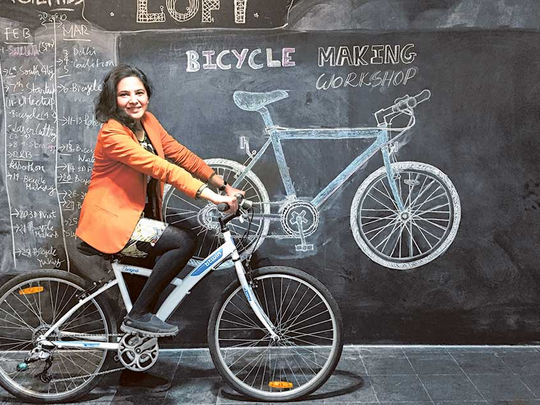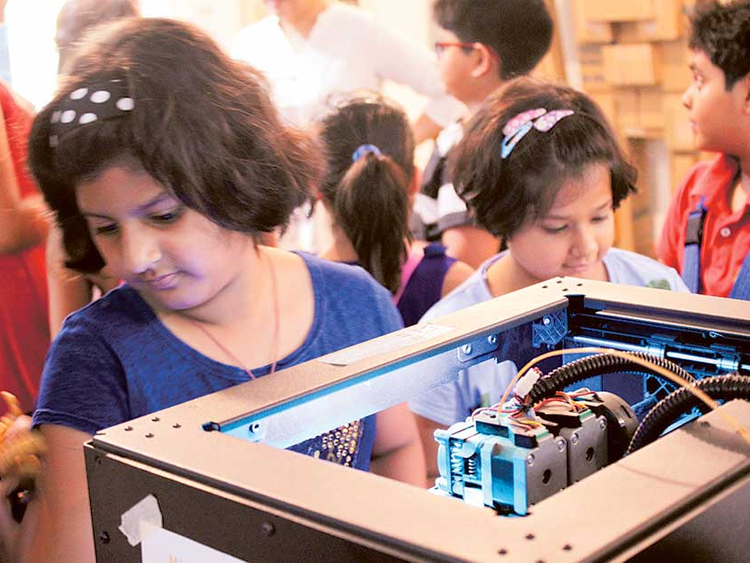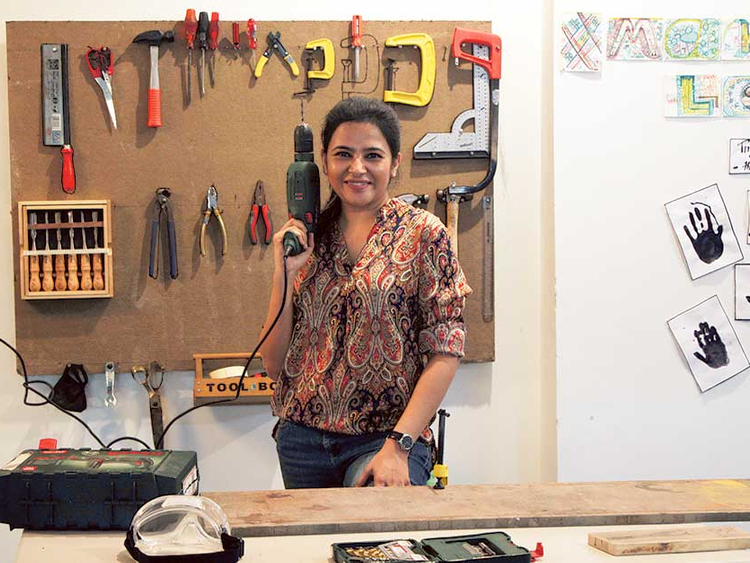
It’s late afternoon on a rainy Saturday in Kolkata. As you enter, your gaze falls on a large art installation that hangs from the ceiling. It is made of used wooden crates. A bookshelf is mounted on a wall at one end — it is fashioned out of cardboard to look like half a human head.
On its shelves are 3D-printed models of the snitch from Harry Potter Quidditich, the iron throne from the “Game of Thrones” and superhero figures. In one corner stands a white BTwin bicycle.
Another wall has a huge array of tools. A couple of exquisitely made paper models of a car and a house sit on top of a high cabinet. In one corner of the vast space, 10-year-old Anoushka Damani is learning animation on Scratch with Priya Sharma, a 3D designer from Guwahati.
In a room on the left, Vivaan Kumar Ghosal is busy working on wood under the watchful eyes of Dipankar Pal. Pal has worked at Isha Home School, a residential school situated at the Isha Yoga Centre near Coimbatore.
In yet another room, a tie-and-dye workshop is in progress. Vivaan’s sister Nibedita is busy painting a tree on a piece of cloth with natural dyes. She is being taught by Sushanto from Shantiniketan. “We use only natural organic dyes,” he says, pointing to a beautiful blue batik top. A colourful tree branch juts out from a wall — it is a sculpture made of recycled scrap fabric.
This is MakersLoft in Kolkata. It is part of a booming worldwide makers movement — a comeback of DIY culture to get people creating, be it for fun, for art or for entrepreneurship. Just think of the old woodshops in people’s homes, or the kind of tinkering your folks did earlier — making things, repairing them instead of throwing them away. The tinkering has become more high tech. Maker Faires are held around the world. Tinkering is being promoted in schools and colleges such as MIT.
Coursera, the leading Massive Open Online Courses (MOOC) provider, even offers a course, called “Tinkering Fundamentals: A Constructionist Approach to STEM Learning”, taught by three scientists from the Exploratorium in San Francisco. Makerspaces are providing much-needed space and tools for people of all ages to build prototypes, explore questions, fail and retry, bounce ideas off one another and build something together.
MakersLoft was set up by 38-year-old marketing executive Meghna Bhutoria who returned to Kolkata from the US. “I owned a lot of tools — when you live abroad, you make things yourself. So did my boyfriend, an architect. Initially I set up a space in my house for myself to tinker around in. Many people in my circle were floored when they saw it. They loved the idea of tinkering with tools. Then someone told me about makerspaces and suggested I could open one.”
And she opened the only makerspace in eastern India and started a culture focused on tinkering, exploration and innovation. She says she was surprised to see the absence of DIY culture in Kolkata when she arrived here from the US.
MakersLoft offers wood and metal working courses, model-making, textiles, working with plastics, electricals and electronics, 3D design and printing, laser cutting, photography and web content. On any given day, you will find people of all ages working on the equipment here — using 3D printers to create wildly inventive shapes out of plastic or resin, or laser cutters to etch materials such as fabric, marble or wood and cut through plastic.
A common space with couches and coffee machines gives people a place to talk or just hang out. The monthly fee at MakersLoft is Rs3,000 (Dh166) and the weekend fee Rs999. All hand tools are free, the use of 3D printer and laser cutter is charged on consumables. It also offers a one year, self paced tinkering course with 100 hours of training. And people of all ages are pouring in — from 7 to 65 years old.
“Books fossilise you,” says Pal. “I told a friend who was completing medical school — by the time you are out, you will be completely conditioned. In our workshops, we spend a few days de-fossilising students,” he says, laughing, and points to the large blackboard on which are scribbled a bevy of symbols denoting chemical elements.
It helps that the space is not a sterile engineering environment. The setting is funky — an exploratory space to try out ideas. MakersLoft members are from a wide variety of backgrounds — students, retired people, designers, architects, entrepreneurs, people in advertising, accountancy or hospitality.
Self-directed learning and making is encouraged at MakersLoft. People are encouraged to tinker with the tools, with the 3D printer, laser cutters and power tools. They are told to come up with an idea, brainstorm, collaborate and give it shape. But Bhutoria says she finds it difficult to get people to be creative and learn and make things.
“We have become so accustomed to rote and textbook learning. I’ve seen working adults, even engineers and architects who are able to design things on computers, become uncomfortable when they are asked to make something with their hands. Kids are easier as they are natural at learning.”
Makers as young as six are dabbling in robotics, playing with organic dyes, creating 3D designs. “We had kids designing solutions to cities and city planning under Project CityX. It was great,” says Bhutoria.
MakersLoft has an interesting mix of “teachers”.
Zubin Advani, who holds model-making sessions, came to know of MakersLoft through a magazine article. He makes wooden and paper scale models for architects, interior designers, and educational institutions.
The installation with wooden crates was created by Hirendra Khushwaha, an artist from Nepal whose work has featured in prominent art galleries in Kolkata. You can find him playing around with scrap material, creating interesting pieces and installations.
A bamboo bicycle-making workshop was held by Nzanthung Kikon, a traditional wood worker from Nagaland. This explains the BTwin bicycle parked next to the wall with tools. “That’s mine. I got it along as a prototype,” says Bhutoria.
Robotics, electronics and Lego workshops are held by Syed Shahidul Islam, a mechanical engineer and DIY hobbyist. French designer Bram Rouws came for the laser cutter and now conducts carpentry workshops at MakersLoft.
Then there’s Volker Schirmer, a 70+ senior expert who from Germany who is teaching CAD to the trainers here. “[There are] many retired specialists like me, who have so much knowledge in their heads, and would like to pass that on,” he says.
This is his first visit to India. He has worked in Egypt, Namibia and Bolivia. “A good knowledge of geometry is required for CAD, also general maths. In most cases, CAD is used to design machine parts such as car gearboxes and weapon parts.”
Over the past few years, several makerspaces have come up across India, including Nuts and Boltz in Delhi, Curiosity Gym and Makers Asylum in Mumbai and Delhi, MakersLoft in Kolkata and similar spaces in Meerut, Chennai, Dharamsala, Ahmedabad and Bengaluru. Kerala has two FabLabs (in Kochi and Thiruvananthapuram) started by Neil Gershenfeld, physicist and the director of MIT’s Center for Bits and Atoms.
The ideology of the makers movement is to discover through sharing and many enthusiasts use the internet to find like-minded people to commune with. “I know most of the makerspace people in India,” says Bhutoria. “We learn from each other. For instance, what equipment and tools to buy, etc. Most of them were set up before MakersLoft.” These spaces are being used for a vast array of projects — from individual tinkering to collaborative efforts to projects that make the world a better place. Restaurateur Riyaaz Amlani used the Maker’s Asylum space in Mumbai to create a bespoke memento for the visiting Duke and Duchess of Cambridge, William and Kate. It was a laser-cut installation showing a combination of Britain’s imperial lion and the Make in India lion logo.
MakersLoft helps to cut out the middleman and create your own product or idea which can then be shared or improved upon.
In Bengaluru, Workbench Projects collaborated with the Red Cross to host a Make-a-thon that worked on assistive devices for the differently abled. Its members have worked on waste management initiatives to turn plastic waste into 3D printer filaments.
At the 90-square-metre Curiosity Gym in Mumbai, people can seek guidance and mentorship on projects they would like to prototype, and attend workshops on 3D printing, Arduino, Raspberry Pi, the internet of things, 3D doodling, making drones, robots, automated gadgets, or work on the design of prototypes. On any given day there are tens of people, from 10 to 60 years old, at the space.
School students, college students, young adults and experienced business professionals looking to make a prototype of a new product they have in mind frequent the Gym. Students also come to Curiosity Gym for special mentorship on science or technology projects.
“We started in 2015. What motivated us was the need to substantially enhance the offering to people of all ages to learn more in a hands-on way,” says Curiosity Gym’s co-founder Girish Nair. “We wanted to be a catalyst for school students from a young age, to be confident of their own ability to create and innovate. For college students again, the ability to do something hands-on was grossly missing in most. We saw that the desire to constantly learn and keep up with an ever-changing world was increasingly being felt by many, including senior citizens. So we crafted a makerspace that could cater to all age groups.”
Girish talks excitedly about students — all from Class VIII — who have designed 3D-printed light sabres, chess clocks, an e-waste segregation system and tiles from e-waste. Students from Class XI have made a wind harness that they submitted to the Google Science Fair, and college students have built a spectrometer, a gesture-controlled robot, a line follower, balancing bots and drones.
Around the country, there are several tinkerers like these who are working on what they hope will be the next brilliant idea — but who don’t have the tools in their garage to build it. It helps that these innovators can set up shop in a makerspace — community workshops where members have access to sophisticated tools and expertise. Members also benefit from the synergy found here, where accomplished people work in close proximity.
“Building something new requires planning, trying, failing, trying again,” says Bhutoria. “People at our space explore creativity, design thinking and develop a sense of persistence. These are incredibly important mindsets for today’s world.”
Around the World
The Maker community is inclusive, vibrant and eclectic, self-organising and widely distributed. Whether they embrace science and technology or arts and crafts, there is a Maker culture generating creative and economic opportunities. Makerspaces have also played an important role in organising resources for local Makers. They provide a shared workshop for Makers to develop projects and provide basic access to tools, materials and expertise, and have established the practices of making in our community.
Things Manchester builds local infrastructures across the city that provide a free internet of things for anyone to use. In London, the Restart Project’s workshops help people repair electronics. Its co-founder Janet Gunter believes that when you maintain or repair, you create value locally in an otherwise throwaway economy where things are manufactured far away. In Bristol, the low-cost DIY solar panel-building workshops of Demand Energy Equality provide neighbours with access to renewable technologies. The Columbus Idea Foundry — a 6,000-square-metre “makerspace” in the heart of Columbus, Ohio — is probably “the largest community ‘makerspace’ on the planet”. Built in a 100-year-old shoe factory, it’s kind of like a gymnasium for people who want to make things.
‘A collective approach to mastering technology together’
The UK-based RSA (Royal Society for the encouragement of Arts, Manufactures and Commerce) brought out a report examining the makerspace movement. “From 3D printing to pottery, and from eco-retrofit classes to Arduino bootcamps, a social movement has emerged based on making and mending. People are learning new skills, creating new enterprises and enjoying the satisfaction of mastering technology and craftsmanship. But this is more than just a rediscovery of craft married to 21st Century technology — this is about a collective approach to mastering technology together. It is as much about being as making,” says the report’s author, Benedict Dellot.
Here’s an excerpt: “The central argument of this report is that makerspaces can help people to master technology for a more human end. In practice, this means enabling people to use and understand tools for three purposes: self-fulfilment, learning and enterprise. Making may indeed be a natural human impulse, we argue, but it is also instrumental in achieving wider life goals — a means as well as an end. Our report goes further to suggest that makerspaces have a role to play in changing our broader worldview. Put another way, they are not just sites to craft objects but also places to champion new values and experiment with a different way of living — one that may be based on the tenets of self-reliance, sustainability and open source thinking. An important question is whether makerspaces can break through into the mainstream. Will they ever appeal to more than just artists, crafts people and those pejoratively known as geeks? The results from our RSA/YouGov survey suggest so. We found that 57 per cent of people would like to learn how to make more things that they and their family could use, and that 24 per cent would be interested in using a makerspace in future.”
Anuradha Sengupta is a writer based in Mumbai.















